Page 235 of 375
Downloaded from www.Manualslib.com manuals search engine When you lift the hood, you’ll see these items on the “VORTEC” 4300 engine:
V
I. Transmission Dipstick
3. Engine Oil Fill
2. Brake Master Cylinder
1. Coolant Recovery Tank
:. Engine Oil Dipstick
6-9
E Power Steering Reservoir
G. Battery
H. Air Cleaner
I. Windshield Washer Fluid
Page 242 of 375
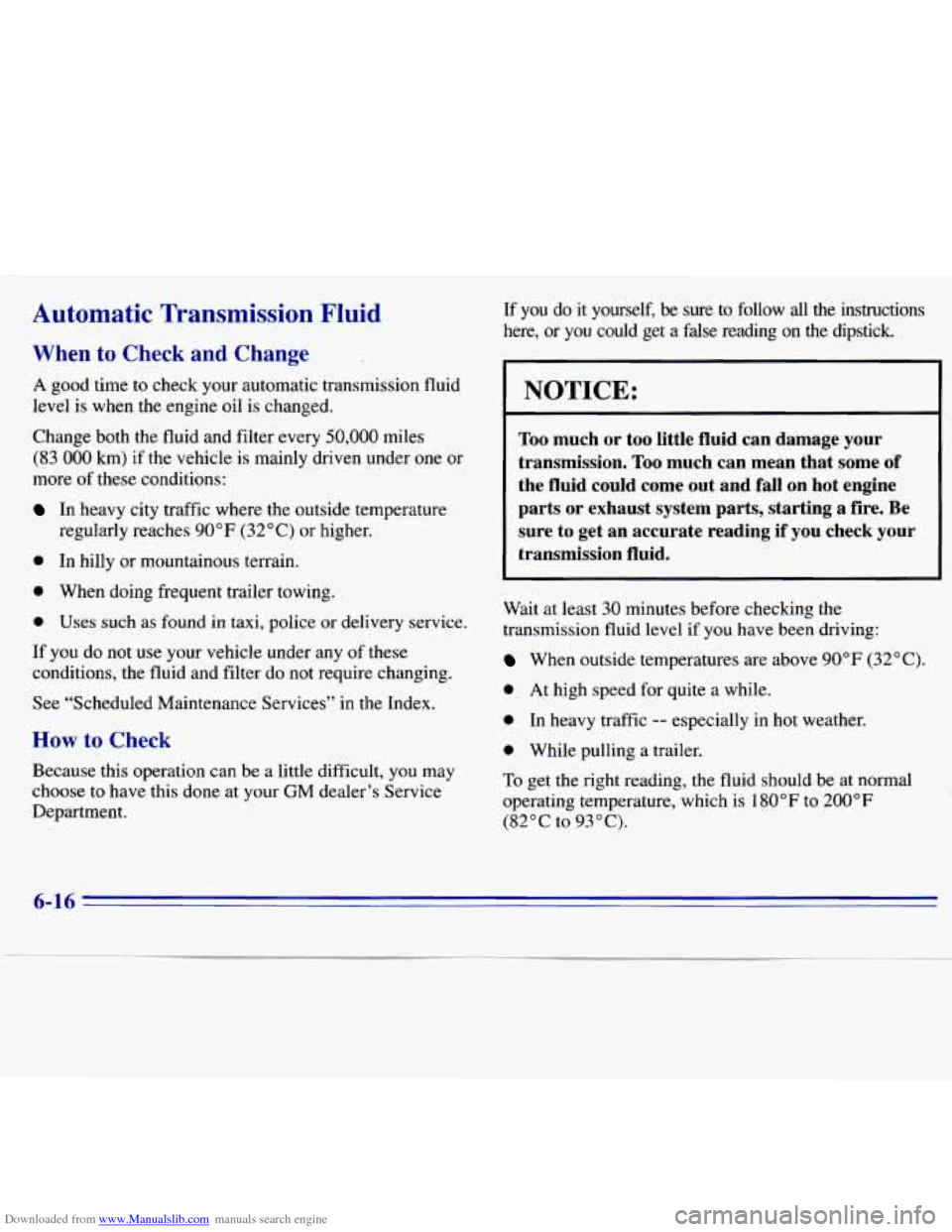
Downloaded from www.Manualslib.com manuals search engine Automatic Transmission Fluid
When to Check and Change
A good time to check your automatic transmission fluid
level is
when the engine oil is changed.
Change both the fluid and filter every
50,000 miles
(83
000 km) if the vehicle is mainly driven under one or
more
of these conditions:
In heavy city traffic where the outside temperature
regularly reaches 90°F (32°C) or higher.
0 In hilly or mountainous terrain.
0 When doing frequent trailer towing.
0 Uses such as found in taxi, police or delivery service.
If you do not use your vehicle under any of these
conditions, the fluid and filter do not require changing.
See “Scheduled Maintenance Services” in the Index.
How to Check
Because this operation can be a little difficult, you may
choose to have this done at your
GM dealer’s Service
Department. If you do it yourself, be sure to follow all the instructions\
here, or
you could get a false reading on the dipstick.
NOTICE:
Too much or too little fluid can damage your
transmission.
Too much can mean that some of
the fluid could come out and fall on hot engine
parts or exhaust system parts, starting a fire. Be
sure to get an accurate reading if you check your
transmission fluid.
Wait at least 30 minutes before checking the
transmission fluid level if
you have been driving:
When outside temperatures are above 90°F (32°C).
0 At high speed for quite a while.
0 In heavy traffic -- especially in hot weather.
0 While pulling a trailer.
To get the right reading, the fluid should be at normal
operating temperature, which is 180°F to
200°F
(82°C to 93°C).
6-16
Page 243 of 375
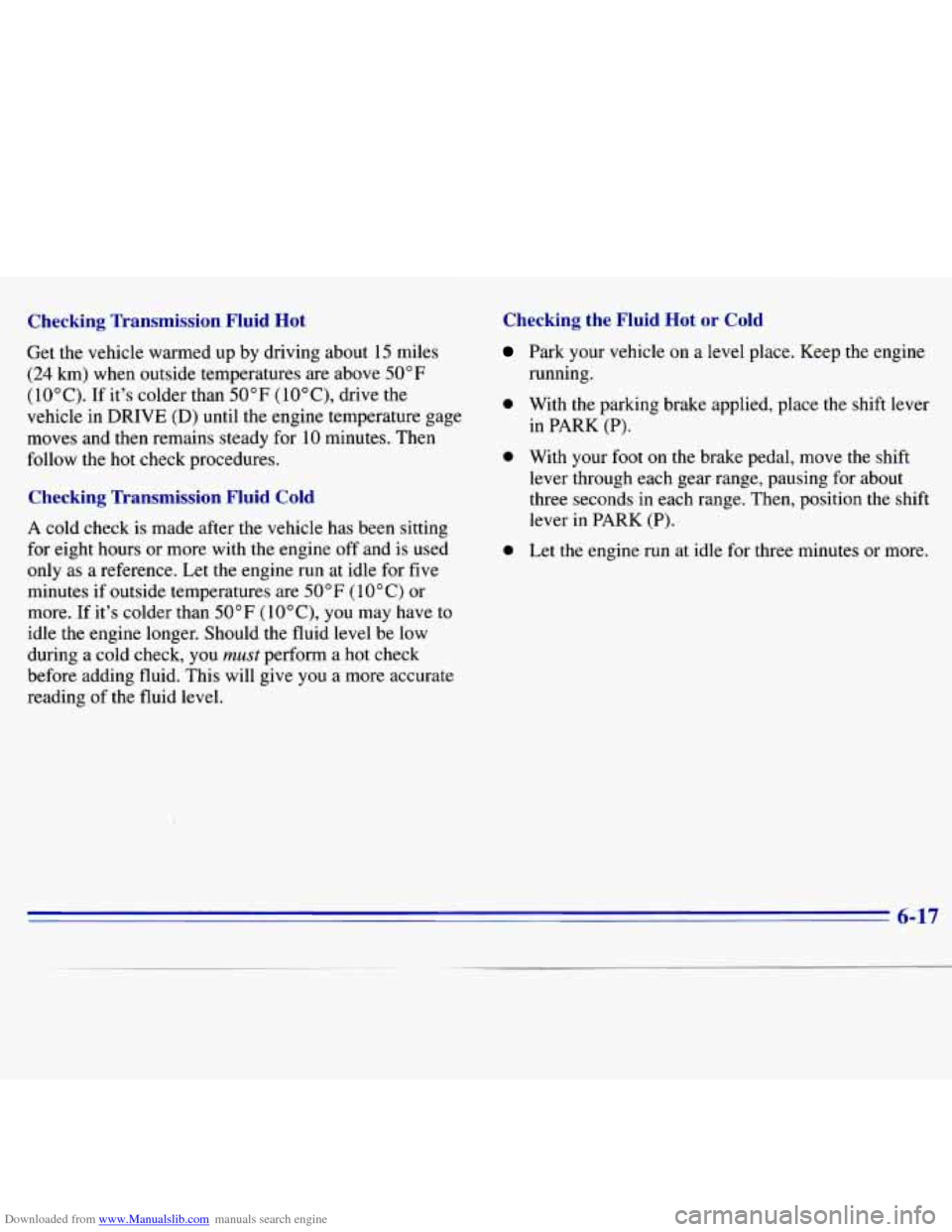
Downloaded from www.Manualslib.com manuals search engine Checking Transmission Fluid Hot
Get the vehicle warmed up by driving about 15 miles
(24 km) when outside temperatures are above 50°F
(10°C). If it's colder than 50°F ( lO"C), drive the
vehicle in DRIVE (D) until the engine temperature gage
moves and then remains steady for
10 minutes. Then
follow the hot check procedures.
Checking Transmission Fluid Cold
A cold check is made after the vehicle has been sitting
for eight hours or more with
the engine off and is used
only as a reference. Let the engine run at idle for five
minutes if outside temperatures are 50°F
(10°C) or
more. If it's colder than 50°F
(lO"C), you may have to
idle the engine longer. Should the fluid level be low
during a cold check, you
must perform a hot check
before adding fluid. This will give you a more accurate
reading of the fluid level.
Checking the Fluid Hot or Cold
Park your vehicle on a level place. Keep the engine
0 With the parking brake applied, place the shift lever
running.
in
PARK (P).
0 With your foot on the brake pedal, move the shift
lever through each gear range, pausing for about
three seconds
in each range. Then, position the shift
lever in
PARK (P).
0 Let the engine run at idle for three minutes or more.
6-17
Page 245 of 375
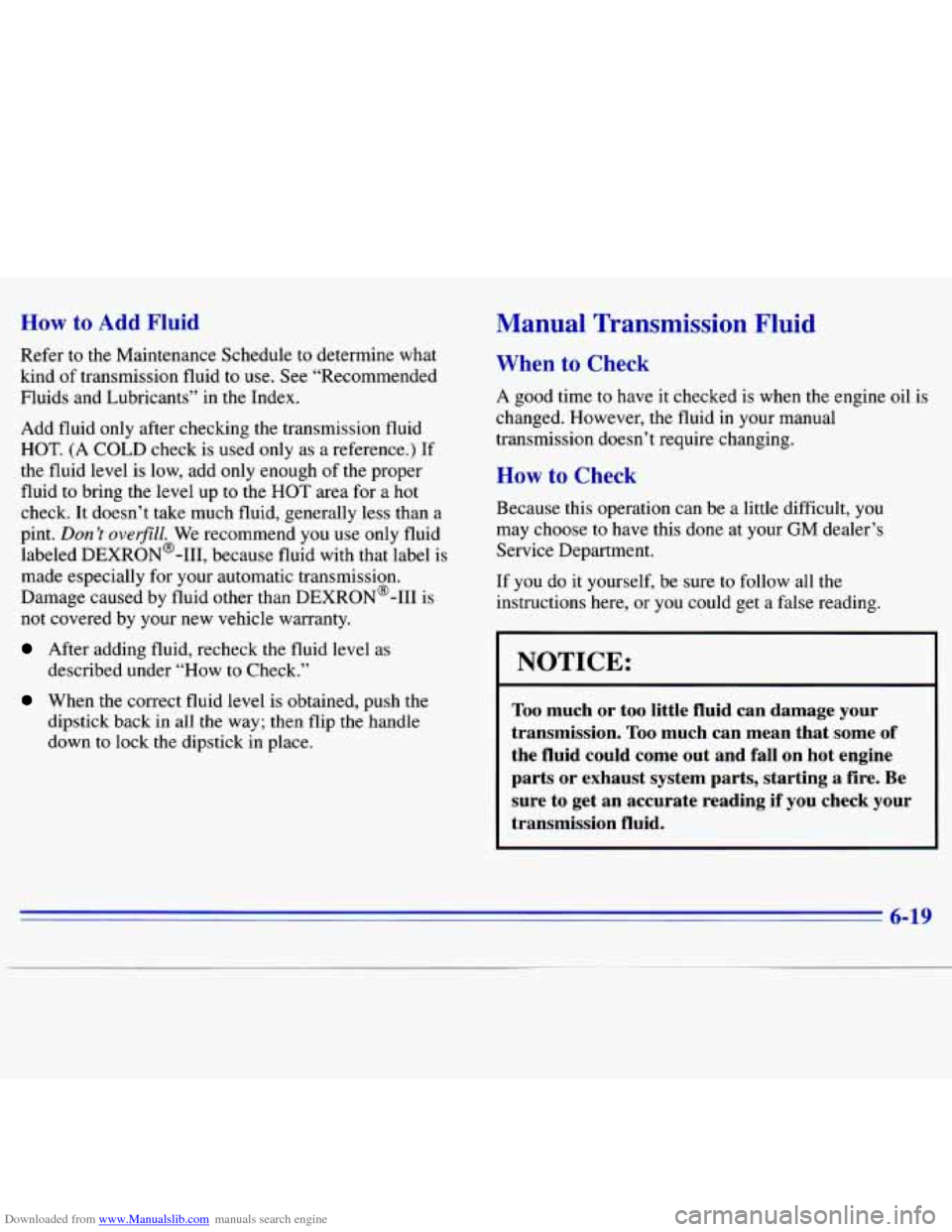
Downloaded from www.Manualslib.com manuals search engine How to Add Fluid
Refer to the Maintenance Schedule to determine what
kind
of transmission fluid to use. See “Recommended
Fluids and Lubricants” in the Index.
Add fluid only after checking the transmission fluid
HOT. (A COLD check is used only as a reference.) If
the fluid level is low, add only enough of the proper
fluid to bring
the level up to the HOT area for a hot
check. It doesn’t take much fluid, generally less than a
pint.
Don’t over-ZZ. We recommend you use only fluid
labeled DEXRON@-111, because fluid with that label
is
made especially for your automatic transmission.
Damage caused by fluid other than DEXRON@-I11 is
not covered by your new vehicle warranty.
After adding fluid, recheck the fluid level as
described under “How to Check.”
When the correct fluid level is obtained, push the
dipstick back
in all the way; then flip the handle
down to
lock the dipstick in place.
Manual Transmission Fluid
When to Check
A good time to have it checked is when the engine oil is
changed. However, the fluid in your manual
transmission doesn’t require changing.
How to Check
Because this operation can be a little difficult, you
may choose to
have this done at your GM dealer’s
Service Department.
If you do it yourself, be sure to follow all the
instructions here, or you could get a false reading.
I NOTICE:
Too much or too little fluid can damage your
transmission.
Too much can mean that some of
the fluid could come out and fall on hot engine
parts or exhaust system parts, starting a fire. Be
sure to get an accurate reading if you check your
transmission fluid.
Page 246 of 375
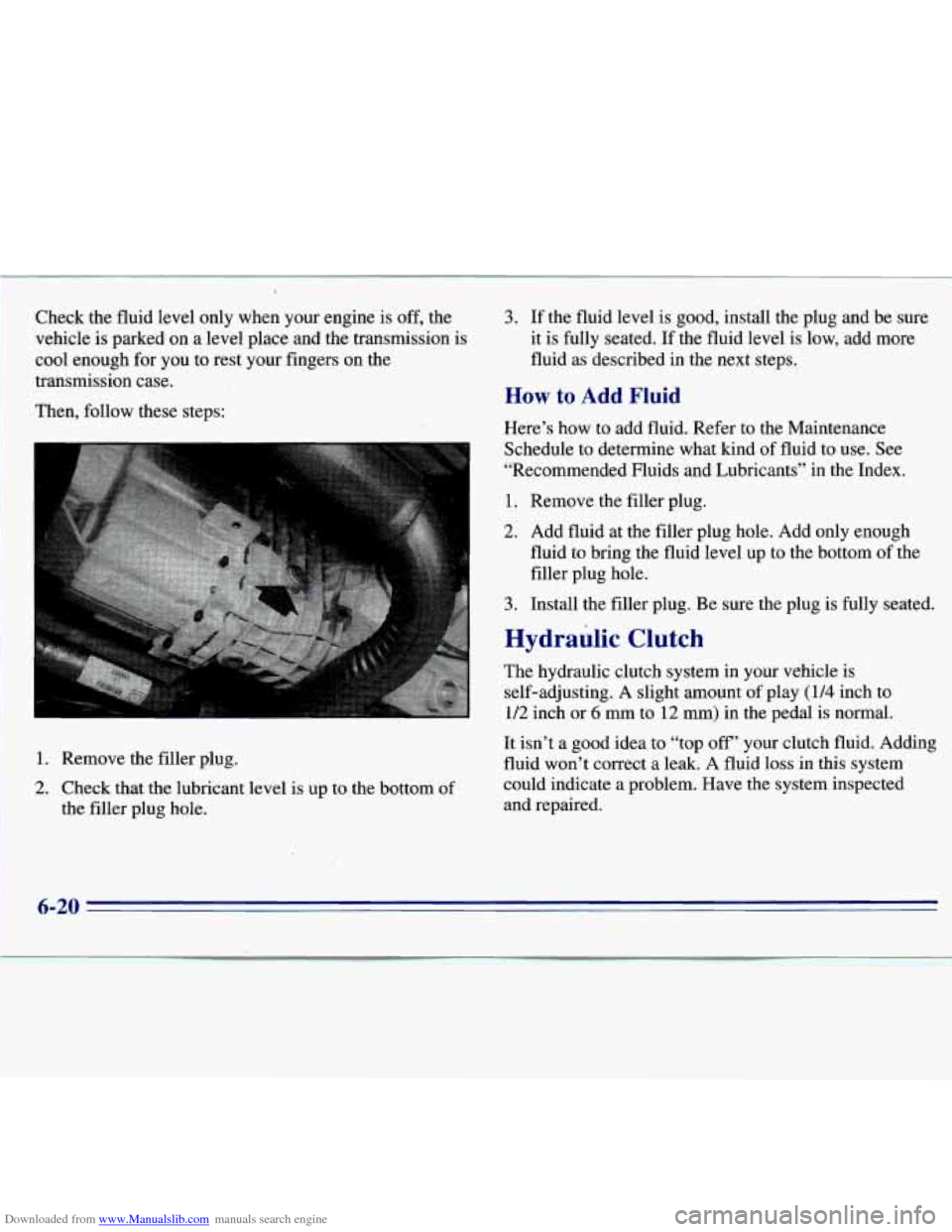
Downloaded from www.Manualslib.com manuals search engine Check the fluid level only when your engine is off, the
vehicle is parked on a level place and the transmission is
cool enough for you to rest your fingers on the
transmission case.
Then, follow these steps: 3. If the fluid level is good, install the plug and be sure
it is fully seated. If the fluid level is low, add more
fluid as described in the next steps.
How to Add Fluid
Here’s how to add fluid. Refer to the Maintenance
Schedule to determine what kind of fluid to use. See
“Recommended Fluids and Lubricants” in the Index.
1. Remove the filler plug.
2. Add fluid at the filler plug. hole. Add only enough
fluid to bring the fluid level up to the bottom of the
filler plug hole.
3. Install the filler plug. Be sure the plug is fully seated.
Hydraulic Clutch -
The hydraulic clutch system in your vehicle is
self-adjusting.
A slight amount of play (1/4 inch to
1/2 inch or 6 mm to 12 mm) in the pedal is normal.
1. Remove the filler plug.
2. Check that the lubricant level is up to the bottom of
the filler plug hole. It isn’t a
good idea to “top
off’ your clutch fluid. Adding
fluid won’t correct a leak. A fluid
loss in this system
could indicate a problem. Have the system inspected
and repaired.
6-20 I
Page 291 of 375
Downloaded from www.Manualslib.com manuals search engine Fuse/Circuit Usage Breaker
7 Power Auxiliary Outlets, Assembly
Line Diagnostic Link
8
9
10
11
12
13
14
15
Not Used
PCMNCM Battery,
ABS Battery, Fuel
Pump (LN2)
PCM/VCM Ignition, Injectors, Crank
Sensor, Coil Driver Module
Radio, Inside Rearview Mirror
Map Lamp
DRAC, Anti-Lock Braking System,
Clock, Radio, Battery,
CD Player
VCM
IGN-3
A/C Compressor Battery Feed
Daytime Running Lamps,
Fog Lamps,
Fog Lamp Relay
Fuse/Circuit Usage Breaker
16
17
19
20 21
22
24 Turn
Signals and Back-up
Lamps, Brake-Transmission
Shift Interlock Solenoid
Windshield Washer, Windshield Wiper Motor
Electric Shift Transfer Case
Crank Signal, Air Bag System
Cluster Illumination,
Radio Illumination, Heater
Lamp, Four- Wheel-Drive
Illumination, Chime Module,
Fog Lamp Illumination
Air Bag System
PRNDL Power, 4L60E Automatic
Transmission
6-65
Page 293 of 375
Downloaded from www.Manualslib.com manuals search engine Normal Maintenance Replacement Parts
Replacement part numbers listed in this section are based on the latest information available at the time of printing,
and are subject
to change. If a part listed in this manual is not the same as the part used in your vehicle when it was
built,
or if you have any questions, please contact your GM truck dealer.
Engine
Thermostat
Oil Filter
Air Cleaner Filter
PCV Valve Automatic Transmission Filter Kit
Spark Plugs
Fuel Filter
Windshield Wiper Blades
2.2L
10 182377
PF47
A1163C
cv9ooc 24200796
4 1-928
GF48 1
Trico (20 inched5
1 cm)
“VORTEC” 4300
1255 1472
PF52
A1 163C
CV746C 24200796
4 1-932
GF48 1
Trico
(20 inched5 1 cm)
6-67
Page 294 of 375
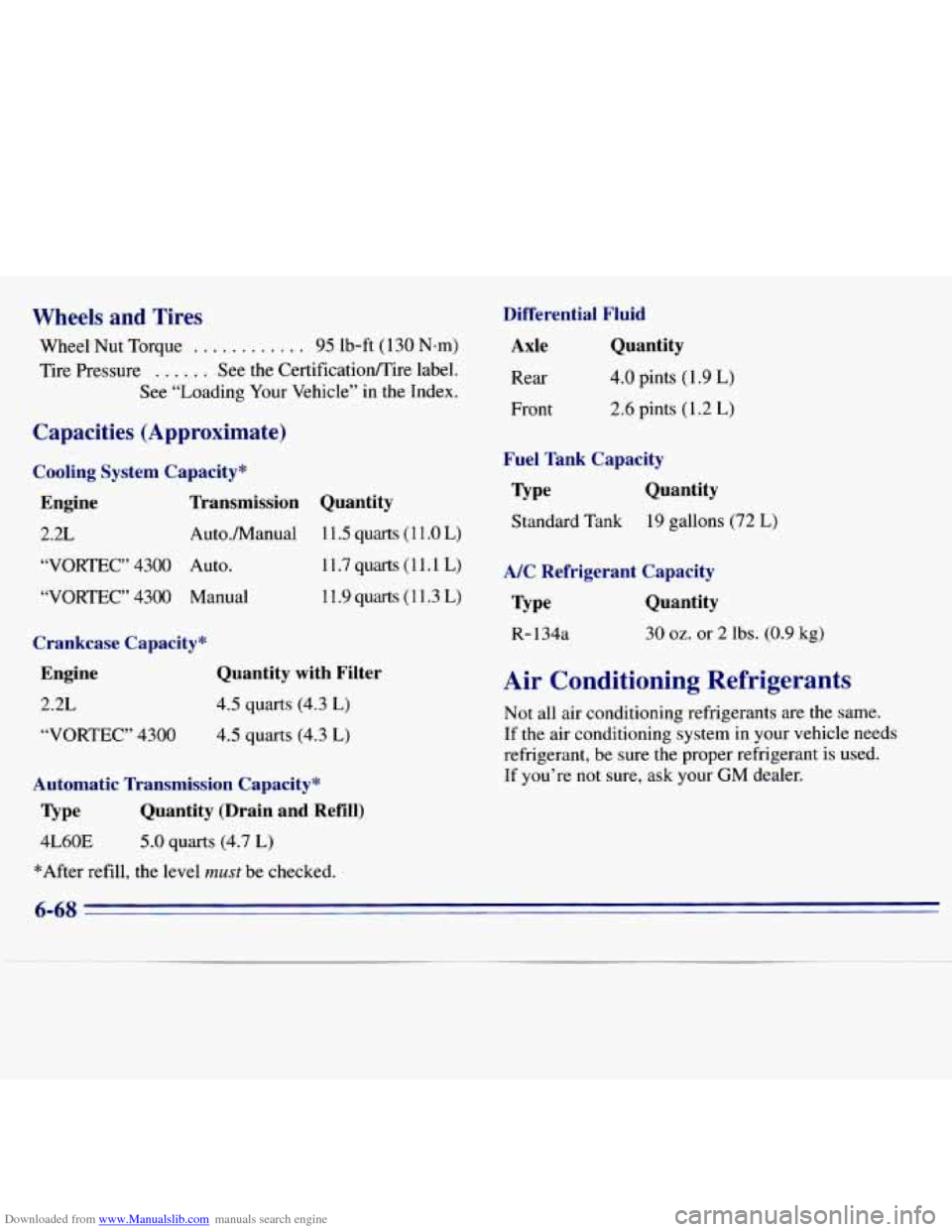
Downloaded from www.Manualslib.com manuals search engine Wheels and Tires
Wheel Nut Torque . . . . . . . . . . . . 95 lb-ft (130 N-m)
Tire Pressure . . . . . . See the Certificatiod‘Tire label.
See “Loading Your Vehicle”
in the Index.
Capacities (Approximate)
Cooling System Capacity*
Engine Transmission Quantity
2.2L Auto./Manual 1 1.5 quarts (1 1 .O L)
“VORTEC” 4300 Auto. 11.7quarts(11.1
L)
“VORTEC” 4300 Manual
11.9quarts(11.3L)
Crankcase Capacity*
Engine Quantity with Filter
2.2L 4.5 quarts (4.3 L)
“VORTEC” 4300 4.5 quarts (4.3 L)
Automatic Transmission Capacity*
Type Quantity (Drain and Refill)
4L60E 5.0 quarts (4.7 L)
*After refill, the level must be checked.
Differential Fluid
Axle Quantity
Rear 4.0 pints (1.9 L)
Front 2.6 pints (1.2 L)
Fuel Tank Capacity
Type Quantity
Standard Tank 19 gallons (72 L)
A/C Refrigerant Capacity
Type Quantity
R- 134a 30 oz. or 2 lbs. (0.9 kg)
Air Conditioning Refrigerants
Not all air conditioning refrigerants are the same.
If the air conditioning system in your vehicle needs
refrigerant, be sure the proper refrigerant is used.
If you’re not sure, ask your GM dealer.
6-68